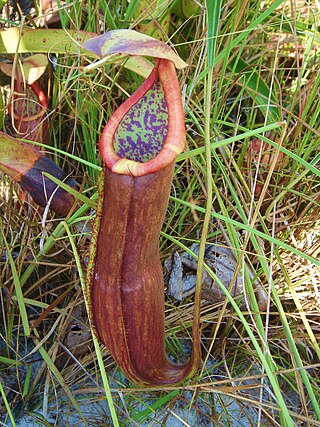
Nepenthes mirabilis, or the common swamp pitcher-plant and tropical pitcher plant, is a carnivorous plant species. By far the most widespread of all Nepenthes, its range covers continental Southeast Asia and all major islands of the Malay Archipelago, stretching from China in the north to Australia in the south. The species exhibits great variability throughout its range. One of the more notable varieties, N. mirabilis var. echinostoma, is endemic to Brunei and Sarawak and possesses an extremely wide peristome.

Nepenthes benstonei is a tropical pitcher plant endemic to Peninsular Malaysia, where it grows at elevations of 150–1350 m above sea level. The specific epithet benstonei honours botanist Benjamin Clemens Stone, who was one of the first to collect the species.

Nepenthes rigidifolia is a critically endangered tropical pitcher plant endemic to Sumatra, where it grows at elevations of 1000–1600 m above sea level.

Nepenthes smilesii is a tropical pitcher plant native to northeastern Thailand, southern Laos, Cambodia, and Vietnam. Nepenthes smilesii can tolerate an extended dry season and is most common in open, sandy savannah and grassland.

Nepenthes bokorensis is a tropical pitcher plant endemic to Cambodia. It is known from Mount Bokor in the south of the country, and an as yet undetermined specimen suggests that it may also be present in other parts of the Dâmrei Mountains of Kampot Province. The specific epithet bokorensis refers to both Mount Bokor and Bokor National Park.

Nepenthes kerrii is a tropical pitcher plant native to Tarutao National Marine Park in southern Thailand, where it grows at elevations of 400–500 m above sea level. The 2018 IUCN assessment also considers the taxon found on Langkawi Island of Malaysia to be conspecific. This species is thought to be most closely related to N. kongkandana. The specific epithet kerrii refers to Irish medical doctor Arthur Francis George Kerr, who made the first known herbarium collection of this species.

Nepenthes kongkandana is a tropical pitcher plant endemic to Songkhla Province in southern Thailand. It is closely related to N. kerrii.
Arthur Francis George Kerr (1877–1942) was an Irish medical doctor. He is known particularly now for his botanical work, which was important for the study of the flora of Thailand.

Nepenthes andamana is a tropical pitcher plant endemic to Phang Nga Province, Thailand, where it grows near sea level in coastal savannah and grassland. It is thought to be most closely related to N. suratensis.

Nepenthes chang is a tropical pitcher plant endemic to the Banthad Mountains of central Thailand, where it grows at elevations of 300–600 m above sea level. It is thought to be most closely related to N. kampotiana.

Nepenthes suratensis is a tropical pitcher plant endemic to Surat Thani Province, Thailand, where it grows near sea level in coastal savannah and grassland. It is thought to be most closely related to N. andamana.

Pitcher Plants of the Old World is a two-volume monograph by Stewart McPherson on the pitcher plants of the genera Nepenthes and Cephalotus. It was published in May 2009 by Redfern Natural History Productions and covers all species known at the time. The work was edited by Alastair Robinson and Andreas Fleischmann.

Nepenthes holdenii is a tropical pitcher plant from western Cambodia, where it grows at elevations of 600–800 m above sea level. The species was originally known from only two peaks in the Cardamom Mountains, but the discovery of a new population was reported in October 2011. Seeds were collected in 2014 and the species was successfully introduced into cultivation.

New Nepenthes: Volume One is a reference work by Stewart McPherson on the pitcher plants of the genus Nepenthes. It was published in 2011 by Redfern Natural History Productions and focuses on discoveries made since the release of McPherson's 2009 monograph, Pitcher Plants of the Old World. The book was edited by Alastair Robinson.

Nepenthes krabiensis is a tropical pitcher plant native to southern Thailand, where it grows at 600–700 m above sea level. It is closely related to N. rosea.
Nepenthes bracteosa is a tropical pitcher plant endemic to Nakhon Si Thammarat province in Thailand. Nepenthes bracteosa differs from the closely allied Nepenthes krabiensis by its shorter stem, filiform spur that are branched, the presence of axillary bud in 2-3 axils in the upper part of the flowering plant, presence of fringed wing in the upper pitcher, lid apex that are occasionally indurate and emarginate, presence of bracts on solitary flowers for both male and female inflorescences, short androphore, and 8-13 anther sacs.
Nepenthes orbiculata is a tropical pitcher plant endemic to Phang Nga Province in Thailand. Among the Nepenthes species associated with N. orbiculata are Nepenthes andamana and Nepenthes mirabilis to which it is sympatric. Particularly, Nepenthes orbiculata is closely related to N. mirabilis but is different in its globose pitchers and its pitcher hip just below the lid, whereas the pitcher in N. mirabilis is more elongate, and the pitcher hip is at the center or in the lower half.. Similarly, Nepenthes orbiculata is closely related to N. mirabilis var. globosa in its glabrous leaves, or leaves with fimbriate margins, and globose pitcher with hip just below the lid. However, N. mirabilis var. globosa is different from N. orbiculata in its climbing habit reaching up to 5 m, and having pitcher that are elongate with lower hips apart from globose ones with hip just below the lid, whereas N. orbiculata is a low shrub about 50 - 150 cm long. Additionally, N. orbiculata is sympatric with N. mirabilis, while N. mirabilis var. globosa is not.













